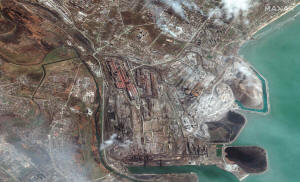'Fortress in a city': Ukrainians cling on at steel plant in Mariupol
 Send a link to a friend
Send a link to a friend
 [April 15, 2022]
By Natalia Zinets [April 15, 2022]
By Natalia Zinets
(Reuters) - Explosions rumbled and smoke
rose this week from a steel making district in besieged Mariupol where
dwindling Ukrainian forces are holed up as Russia tries to take full
control of its biggest city yet.
The Azovstal iron and steel works, one of Europe's biggest metallurgical
plants, has become an aptly apocalyptic redoubt for Ukrainian forces who
are outgunned, outnumbered and surrounded seven weeks into Russia's
invasion of Ukraine.
In the east of the southern port devastated by weeks of shelling, the
plant lies in an industrial area that looks out to the Sea of Azov and
covers more than 11 square kilometres (4.25 square miles), containing
myriad buildings, blast furnaces and rail tracks.
"The Azovstal factory is an enormous space with so many buildings that
the Russians ... simply can't find (the Ukrainian forces)," said Oleh
Zhdanov, a military analyst based in Kyiv.
"That's why they (the Russians) started talking about trying a chemical
attack, that's the only way to smoke them out," Zhdanov said.

Ukraine has said it is checking unverified information that Russia may
have used chemical weapons in Mariupol. Russia-backed separatists have
denied using chemical weapons.
In peace time, the Azovstal iron and steel works pumped out 4 million
tonnes of steel a year, 3.5 million tonnes of hot metal and 1.2 million
tonnes of rolled steel.
Like the city's other Illich Steel and Iron Works, Azovstal is held by
Metinvest, the group controlled by billionaire Rinat Akhmetov, Ukraine's
richest man.
A Russian separatist deputy commander said on Russian state TV on Monday
that Moscow had captured 80% of the port, but that resistance continued
and that Ukrainian forces had all tried to "exit towards the Azovstal
factory".
He described the factory as a "fortress in a city".
The city's defenders include Ukrainian marines, motorised brigades, a
National Guard brigade and the Azov Regiment, a militia created by
far-right nationalists that was later incorporated into the National
Guard.
It is the Azov Regiment, whose destruction is among Moscow's war
objectives, that is prominently associated with Azovstal and one of its
founders, Andriy Biletskiy, has also called it "the fortress of the
Azov".
Russian President Vladimir Putin calls the invasion a "special
operation" for the "demilitarisation and denazification of Ukraine" but
Ukraine and the West say Russia launched an unprovoked war of
aggression.

"Azov is indeed on Azovstal's territory ... These are huge territories
with workshops that can't be destroyed from the air, which is why the
Russians are using heavy bombs," said Sergiy Zgurets, a military
analyst.
Russia's defence ministry said on Wednesday that more than 1,000
soldiers of Ukraine's 36th Marine Brigade, including 162 officers, had
surrendered in Mariupol, though Ukraine has not confirmed that.
[to top of second column]
|

A satellite image shows an overview of Azovstal Iron and Steel Works
in Mariupol, Ukraine, April 9, 2022. Satellite image 2022 Maxar
Technologies/Handout via REUTERS
 Ukrainian presidential adviser
Oleksiy Arestovych later said that members of the 36th Marine
Brigade had managed to punch through in a "highly risky manoeuvre"
to join up with the Azov Regiment.
"The 36th brigade avoided being ripped to pieces and now have
serious additional opportunities, essentially getting a second
chance," he said.
The lack of mobile reception and internet in the city means
information is scant. Ukraine has kept tight control of things like
troop numbers that could compromise their defence.
The Azov's Biletskiy told Ukraine's NV news site on March 20 that
Ukraine had a total of 3,000 fighters defending the city against up
to 14,000 Russians.
DIFFICULT TO OCCUPY
Private U.S. satellite company Maxar was able to peer down at the
raging battles from space on Tuesday.
"Smoke and fire was observed coming from a number of buildings
throughout the western and eastern sections of the city as well as
in and near the Azovstal iron and steel works factory — the site of
ongoing battles between Russian and Ukrainian forces," it said.
An EU security source told Reuters it was to difficult to say how
long the Ukrainians could hold on and also difficult for Russia to
occupy the whole city because of the industrial complexes. "There
are underground tunnels systems under the steel factory."
"Mariupol is very important to Putin because after a victory there
(and the surrender of Azov-troops) he can claim that the 'denazification'
process is successful," the source added.

An assistant to Mariupol's mayor said on Wednesday that Russia
planned to celebrate victory in the city on May 9, the date Moscow
marks victory over Nazi Germany in World War Two with an annual
parade on Red Square.
Zhdanov, the military analyst, said he saw little chance of
Ukrainian forces from the outside breaking through Russia's siege.
"How many supplies the defenders have and how long they can hold on
is anyone's guess. But they have no other way out. They're
surrounded on all sides, they have to stand till the end. If they
give in, they will not be spared," he said.
(Reporting by Natalia Zinets; Additional reporting by Pavel Polityuk;
editing by Grant McCool)
[© 2022 Thomson Reuters. All rights
reserved.] This material may not be published,
broadcast, rewritten or redistributed.
Thompson Reuters is solely responsible for this content.
 |